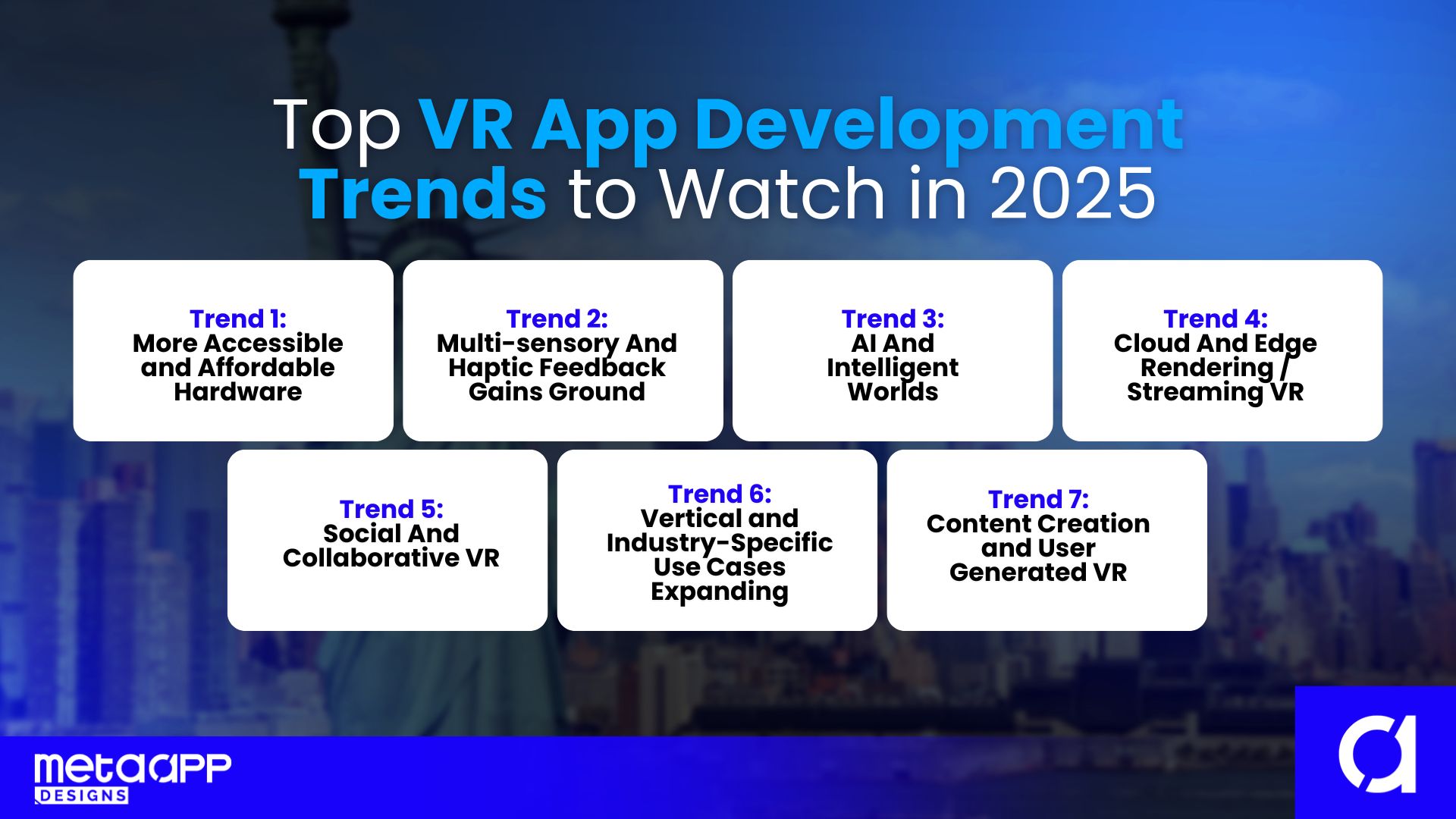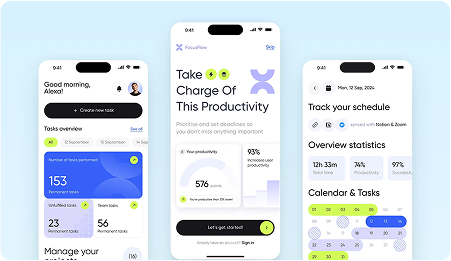
Top VR App Development Trends to Watch in 2025
Imagine you slip on a light headset and step into a classroom on Mars. And suddenly, the sky glows red, and lessons happen all around you. No, this his isn’t science fiction anymore. In 2025 virtual reality is lighter, faster, and cheaper. Hence, reaching schools, offices, and homes everywhere.
Thank you for reading this post, don't forget to subscribe!
This shift is huge for anyone exploring VR app development. New tools and devices are changing how we build immersive worlds. If your company wants to tap into virtual reality app development services, it’s time to know what’s coming. This article will walk you through the biggest VR trends of 2025 and how vr development services are growing to match them.

Trend 1: More Accessible & Affordable Hardware
Table Of Content
Until recently, VR meant heavy headsets and powerful PCs. So, that kept many people out. But in 2025, this is changing fast. Headsets are lighter, cheaper, and work without a computer. Because of this shift, more people can try VR at home, at school, or at work.
Also, standalone devices like the Meta Quest line show how easy VR can be. You just put it on, turn it on, and start exploring. This makes virtual reality mobile app development more important than ever.
For VR app development teams, this means designing experiences . Ones that use fewer resources. However, still feel rich. With smart coding and good design, even lighter hardware can deliver great results. As prices drop, the audience grows. And as the audience grows, virtual reality app development services need to think mobile-first, flexible, and future-ready.
Trend 2: Multi-sensory & Haptic Feedback Gains Ground
Right now most VR gives you sight and sound. However, in 2025 that is changing. Step by step, touch is joining the mix. Haptic gloves, vests, and even shoes. These let users feel pressure, heat, or movement. And the result? The world inside a headset starts to feel real, not just look real.
Because of this shift, virtual reality applications development must plan for more than graphics and audio. Developers now need to think about how a user’s hand moves, what textures feel like, and how force feedback works. This is especially true in training, games, and medical simulations.
In addition, these new tools are not cheap or simple. They need careful setup, calibration, and support. Yet costs are slowly falling, and standards are improving. Therefore, now is the time for vr app development teams to experiment. By doing so, they can get ahead as virtual reality app development services expand to include touch, motion, and even smell.
Trend 3: AI & Intelligent Worlds
Until now, most VR worlds felt fixed. However, in 2025, artificial intelligence is making them smart. Because of AI, people inside VR can meet characters who speak, learn, and react in real time. This makes every trip inside a headset feel fresh.
As a result, vr app development is changing. Developers can now use machine learning to build scenes that adapt to each user. For example, a training app can change tasks if someone struggles. Likewise, a game can create new levels on the spot.
In addition, large language models (LLMs) are helping make conversations inside VR smooth and natural. Therefore, vr development services are starting to offer tools for smarter dialogue, storylines, and content creation.
Yet there are tradeoffs. More AI means more processing power and also more ethical choices. Who controls the data? How do we keep it safe? Because of these questions, every virtual reality app development company needs clear rules. By planning early, teams can enjoy AI’s power while protecting users and keeping performance strong.
Trend 4: Cloud & Edge Rendering / Streaming VR
In the past, VR needed strong computers inside every headset. However, in 2025 this is changing. Because cloud and edge computing are growing fast, heavy work can move to distant servers. As a result, headsets can stay light, cool, and cheap.
With this shift, people can stream rich VR worlds the way they stream videos. Therefore, virtual reality mobile app development can reach more users on phones, tablets, and lighter headsets. Also, 5G and edge networks lower the lag between a user’s action and the VR response. This makes the experience smoother and more fun.
In addition, this change forces vr app development teams to think about new setups. Apps must handle online connections, servers, and updates. They must also plan for times when the link is slow or drops.
Because of these needs, virtual reality app development services are adding cloud skills to their work. By doing so, they can build apps that run fast, look good, and work anywhere users go.
Trend 5: Social & Collaborative VR
VR used to feel like a private world. However, in 2025 that picture is changing. Because headsets are cheaper and the internet is faster. Hence, more people can meet in shared virtual spaces. As a result, VR is becoming social and team-friendly instead of lonely.
Now you can hold meetings, classes, or events inside VR. Therefore, vr app development must support groups, chat, and shared tools by default. Also, students and workers can join from anywhere, making learning and work more flexible.
In addition, platforms like Meta Workrooms and other spatial apps show how teams can brainstorm or design together inside 3D rooms. This shift helps businesses cut travel costs and improve teamwork.
Because of these changes, virtual reality app development services are adding social features to almost every new project. They build ways for users to talk, move, and create together. Creative! By doing so, they make VR more useful for schools, offices, and even friends. hence, people who just want to hang out.
Trend 6: Vertical and Industry-Specific Use Cases Expanding
VR once focused on games. However, in 2025 it is spreading into many industries. Because hardware is cheaper and apps are easier to build, businesses can now use VR for real work, not just play. As a result, virtual reality applications development is less “one size fits all” and more custom-made.
For example, doctors can train for surgery inside safe 3D rooms. Therefore, hospitals ask vr app development teams for tools that feel like the real thing. In addition, real estate agents can give house tours without leaving the office. Retail stores can let shoppers try clothes or makeup in virtual mirrors. Schools can teach science by placing students inside space or the ocean.
Because of this trend, virtual reality app development services must design for each field. They build special features, rules, and layouts to fit every job. By doing so, they help companies save time, cut risk, and create better results for customers.
Trend 7: Content Creation and User-Generated VR
In the past, only skilled coders could build VR worlds. However, in 2025 that barrier is falling. Because new tools are simple, almost anyone can create scenes, games, or lessons in VR. As a result, user-generated content (UGC) is rising fast.
Now, no-code and low-code platforms let teachers, shop owners, and hobbyists build VR spaces. Therefore, vr development services must support plug-ins, templates, and easy uploads. In addition, they must make sure content stays safe and runs well on different devices.
This shift matters for every virtual reality app development company. It means apps are no longer closed systems. They are open stages where users add their own ideas. Because of this change, teams must plan for moderation, quality checks, and updates.
By doing so, virtual reality app development services can offer flexible platforms that grow with their communities. They can give users tools to create, share, and explore without heavy training. In turn, the VR world becomes larger, richer, and more personal for everyone.
| Trend / Area | What’s New in 2025 | Why It Matters for VR App Development |
| Affordable Hardware | Standalone headsets, lighter devices | Developers must optimize for lower specs and mobile-first |
| Multi-sensory Haptics | Gloves, suits, motion feedback | Apps must plan for touch, movement, and new inputs |
| AI & Intelligent Worlds | Smarter NPCs, adaptive training | Apps can feel alive but need more power and ethics planning |
| Cloud / Edge Streaming | Offload heavy computing to servers | Makes VR faster on lighter devices but adds network needs |
| Social & Collaborative VR | Shared spaces, team work, events | Apps should include chat, avatars, and group tools |
Challenges and Considerations
VR is exciting. However, it also brings problems that businesses must plan for. Because headsets vary in power and size, apps may not work the same on each device. As a result, vr app development teams need to test on many models.
In addition, motion sickness can still happen. For example, a 2024 Stanford study found that clearer visuals and 90-fps refresh rates cut motion sickness by 35%. Therefore, apps should use smooth movement and clear visuals to keep users comfortable.
Privacy is another big issue. Because VR collects data about how people move, companies must protect that data.
Also, costs can rise quickly. Hardware, updates, and support all add up. Standards are still evolving too. Therefore, developers must watch new rules and changes in software kits.
By facing these challenges early, virtual reality app development services can build safer, smoother, and cheaper apps. They can also earn trust from users and stand out in a crowded market.

VR Security and Ethics
VR can feel magical. However, it also collects a lot of personal data. Because headsets track hands, eyes, and voices, companies must protect that data carefully. As a result, privacy is not just a legal box to tick. It is a trust issue.
Therefore, vr app development teams need clear rules for how data is stored, shared, and deleted. They should use strong encryption and explain policies in plain words. In addition, apps must be built for all users, including people with disabilities. Simple menus, clear text, and sound cues can make VR more accessible.
Ethics go beyond safety. Developers should ask if features might cause harm or bias. Because of these concerns, virtual reality app development services that take security and ethics seriously will stand out. They will win user trust and help grow VR as a safe, fair, and welcoming space.
How to Ride These Trends
VR is moving fast. However, with a clear plan, your team can keep up. First, start small. Because new tools appear often, it is safer to test ideas before big launches. As a result, you save time and money.
Next, build apps in parts. Therefore, you can add new features as hardware improves. Also, keep your code and design modular. This makes updates easier and faster.
In addition, choose a virtual reality app development company or vr development services provider that understands future tech. They should follow new headsets, SDK updates, and best practices. By doing so, your app will stay strong as the market changes.
Finally, invest in research and training. Because the field shifts quickly, learning never stops. Therefore, your team stays ready for fresh tools, new rules, and rising user demands.
Conclusion
VR is no longer a distant dream. However, in 2025 it is a real tool for schools, work, and play. Because hardware, AI, and networks are growing together, the future of vr app development looks bright. As a result, companies can reach bigger audiences and build richer worlds.
Therefore, now is the time to act. By working with skilled virtual reality app development services or a future-ready virtual reality app development company, you can stay ahead. In addition, you can shape the next wave of immersive apps and help users enjoy safe, smart, and powerful VR experiences.
Frequently Asked Questions
VR app development means making software for headsets or phones. Because VR uses 3D worlds, developers build scenes, sounds, and actions that feel real inside a headset.
Costs vary. However, simple apps may start low, while complex training or games need bigger budgets. Therefore, a virtual reality app development company can give clear quotes first.
Yes. Because headsets now run on their own chips, many VR apps also link to phones. As a result, virtual reality mobile app development is growing fast.
- virtual reality app development company
- virtual reality app development services
- Virtual Reality Applications Development
- virtual reality mobile app development
- VR app development
Table Of Content






